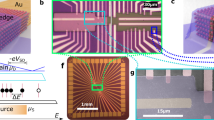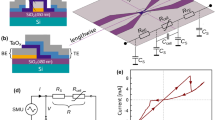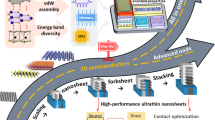Abstract
Transistors are the basis for electronic switching and memory devices as they exhibit extreme reliabilities with on/off ratios of 104–105, and billions of these three-terminal devices can be fabricated on single planar substrates. On the other hand, two-terminal devices coupled with a nonlinear current–voltage response can be considered as alternatives provided they have large and reliable on/off ratios and that they can be fabricated on a large scale using conventional or easily accessible methods. Here, we report that two-terminal devices consisting of discontinuous 5–10 nm thin films of graphitic sheets grown by chemical vapour deposition on either nanowires or atop planar silicon oxide exhibit enormous and sharp room-temperature bistable current–voltage behaviour possessing stable, rewritable, non-volatile and non-destructive read memories with on/off ratios of up to 107 and switching times of up to 1 μs (tested limit). A nanoelectromechanical mechanism is proposed for the unusually pronounced switching behaviour in the devices.
This is a preview of subscription content, access via your institution
Access options
Subscribe to this journal
Receive 12 print issues and online access
$259.00 per year
only $21.58 per issue
Buy this article
- Purchase on Springer Link
- Instant access to full article PDF
Prices may be subject to local taxes which are calculated during checkout




Similar content being viewed by others
References
Lau, C. N., Stewart, D. R., Williams, R. S. & Bockrath, M. Direct observation of nanoscale switching centers in metal/molecule/metal structures. Nano Lett. 4, 569–572 (2004).
Terabe, K., Hasegawa, T., Nakayama, T. & Aono, M. Quantized conductance atomic switch. Nature 433, 47–50 (2005).
Dong, Y., Yu, G., McAlpine, M. C., Lu, W. & Lieber, C. M. Si/a-Si core/shell nanowires as nonvolatile crossbar switches. Nano Lett. 8, 386–391 (2008).
Kinoshita, K., Tamura, T., Aoki, M., Sugiyama, Y & Tanaka, H. Bias polarity dependent data retention of resistive random access memory consisting of binary transition metal oxide. Appl. Phys. Lett. 89, 103509 (2006).
Wuttig, M. & Yamada, N. Phase-change materials for rewriteable data storage. Nature Mater. 6, 824–832 (2007).
Li, J. & Zhang, Q. Room-temperature negative differential conductance in carbon nanotubes. Carbon 43, 667–670 (2005).
Li, Y. F., Hatakeyama, R., Kaneko, T., Kato, T. & Okada, T. Negative differential resistance in tunneling transport through C60 encapsulated double-walled carbon nanotubes. Appl. Phys. Lett. 90, 073106 (2007).
Larade, B., Taylor, J., Mehrez, H. & Guo, H. Conductance, I–V curves, and negative differential resistance of carbon atomic wires. Phys. Rev. B 64, 075420 (2001).
Farajian, A. A., Esfarjani, K. & Kawazoe, Y. Nonlinear coherent transport through doped nanotube junctions. Phys. Rev. Lett. 82, 5084–5087 (1999).
Léonard, F. & Tersoff, J. Negative differential resistance in nanotube devices. Phys. Rev. Lett. 85, 4767–4770 (2000).
Rueckes, T. et al. Carbon nanotube-based nonvolatile random access memory for molecular computing. Science 289, 94–97 (2000).
Franklin, N. R. et al. Integration of suspended carbon nanotube arrays into electronic devices and electromechanical systems. Appl. Phys. Lett. 81, 913–915 (2002).
Cha, S. N. et al. Fabrication of a nanoelectromechanical switch using a suspended carbon nanotube. Appl. Phys. Lett. 86, 083105 (2005).
Dujardin, E., Derycke, V., Goffman, M. F., Lefèvre, R. & Bourgoin, J. P. Self-assembled switches based on electroactuated multiwalled nanotubes. Appl. Phys. Lett. 87, 193107 (2005).
Deshpande, V. V. et al. Carbon nanotube linear bearing nanoswitches. Nano Lett. 6, 1092–1095 (2006).
Jang, J. E. et al. Nanoscale memory cell based on a nanoelectromechanical switched capacitor. Nature Nanotech. 3, 26–30 (2008).
Nguyen, D. N., Guertin, S. M., Swift, G. M. & Johnston, A. H. Radiation effects on advanced flash memories. IEEE Trans. Nucl. Sci. 46, 1744–1750 (1999).
Cellere, G. et al. Total ionizing dose effects in NOR and NAND flash memories. IEEE Trans. Nucl. Sci. 54, 1066–1070 (2007).
Wang, X. et al. Room-temperature all-semiconducting sub-10-nm graphene nanoribbon field-effect transistors. Phys. Rev. Lett. 100, 206803 (2008).
Echtermeyer, T. J. et al. Nonvolatile switching in graphene field-effect devices. IEEE Electron Device Lett. 29, 952–954 (2008).
Collins, P. G., Hersam, M., Arnold, M., Martel, R. & Avouris, R. Current saturation and electrical breakdown in multiwalled carbon nanotubes. Phys. Rev. Lett. 86, 3128–3131 (2001).
Standley, B. et al. Graphene-based atomic-scale switches. Nano Lett. 8, 3345–3349 (2008).
Li, Y. B., Bando, Y. & Golberg, D. SiC–SiO2–C coaxial nanocables and chains of carbon nanotube-SiC heterojunctions. Adv. Mater 16, 93–96 (2004).
Acknowledgements
This work was partially supported by NASA through the TiiMS URETI. The authors thank Y. Bando and D. Golberg of the National Institute for Materials Science, Tsukuba, Japan, for kindly providing G–SiO2–SiC nanocables.
Author information
Authors and Affiliations
Contributions
Y.L. synthesized G-coated nanocables. Y.L. and A.S. carried out device fabrication, SEM and AFM analyses and electrical measurements. Y.L. also carried out HRTEM analysis. Y.L., A.S. and J.M.T. wrote the paper. J.M.T. oversaw all phases of the research.
Corresponding author
Supplementary information
Supplementary Information
Supplementary Information (PDF 592 kb)
Rights and permissions
About this article
Cite this article
Li, Y., Sinitskii, A. & Tour, J. Electronic two-terminal bistable graphitic memories. Nature Mater 7, 966–971 (2008). https://doi.org/10.1038/nmat2331
Received:
Accepted:
Published:
Issue Date:
DOI: https://doi.org/10.1038/nmat2331
This article is cited by
-
2D materials: increscent quantum flatland with immense potential for applications
Nano Convergence (2022)
-
Review of applications of 2D materials in memristive neuromorphic circuits
Journal of Materials Science (2022)
-
A comprehensive review on fundamental properties and applications of poly(vinylidene fluoride) (PVDF)
Advanced Composites and Hybrid Materials (2021)
-
Graphene memristive synapses for high precision neuromorphic computing
Nature Communications (2020)
-
Oxide-based RRAM materials for neuromorphic computing
Journal of Materials Science (2018)



